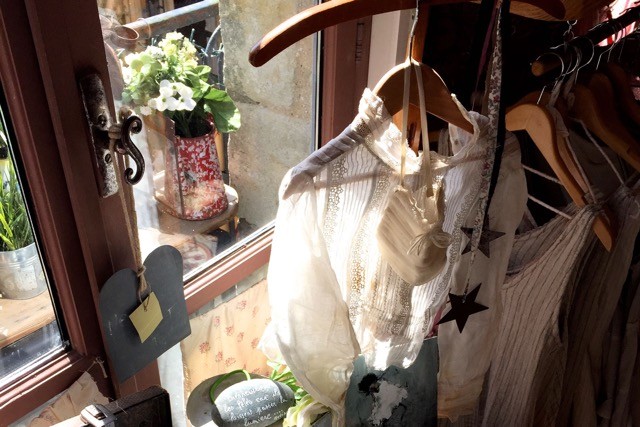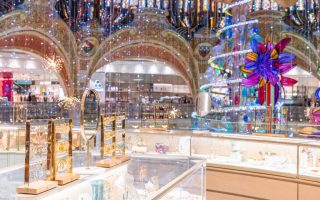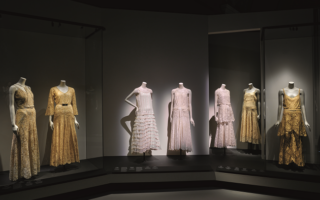French Fashion for Summer: Bobo Romantic

There’s a little shop in Uzès, France where “women of a certain style” flock all times of the year. In summer, they pour out of the lace-curtained door of L’atelier des Ours in a steady stream, all carrying pink packages filled with pretty feminine things.
The fashions you find at L’atelier des Ours can be described as “bobo” or “bourgeois bohemian.” The term was first coined by David Brooks, in his book “Bobos in Paradise: The New Upper-Class and How They Got There.” He describes “bourgeois bohemians” as “highly educated folk who have one foot in the bohemian world of creativity and another foot in the bourgeois realm of ambition and worldly success.”
Yes, “Bobos” love the bobo style. So do ordinary people. I believe it is because of its deep roots in an age long ago.
A Return to the Age of Romance
I visit the little shop that is at the end of my street when I want to step away from an ordinary day into a fantasy place. Literally back in time. From the stopped clock to the butterflies and cupids that sit on the shelves, there is something different here.
It’s Summer 1798. The Dashwood sisters, Elinor and Marianne, are chattering in the upstairs dressing room. They are visiting from Paris hoping to find something appropriate for Marianne to wear to charm her suitor. Jane Austen is in the adjoining space taking notes.
“I could not be happy with a man whose taste did not in every point coincide with my own,” says Marianne as she slips into a cream colored crinoline. “He must enter into all my feelings;” she sighed, “the same books, the same music must charm us both.”
“Did he tell you that he loved you?” Elinor asks, as she helps Marianne fasten a flowered skirt around her tiny waistline.
Marianne is thoughtfully silent. Slowly she pushes her slender arms through the sleeves of the jacket Elinor is holding behind her.
“Yes,” Marianne says as she steps to the mirror. “No,” she then adds, looking impishly at Elinor. “Never absolutely,” Marianne confesses. “It was everyday implied but never declared.”
With that, Marianne stands firmly in front of the mirror and gazes at her reflection. Her attention goes to the figure she sees before her. She glances at Elinor for a sign of approval.
“Sometimes one is guided by what they say of themselves,” states Elinor, prodding her sister to speak her own mind, “and very frequently by what other people say of them,” she adds, “without giving oneself time to deliberate and judge.”
Marianne turns quickly, walks to the dressing room; removes the jacket; unbuttons the skirt, and pulls the chemise over her head. She puts on her street clothes and walks out of the dressing room, new outfit in hand.
“At my time of life opinions are tolerably fixed,” says Marianne happily. “It is not likely that I should now see or hear anything to change them,” she chirps.
Shortly, Marianne and Elinor walk out the lace-curtained door with Jane Austen in tow. Jane is carrying a pink package filled with Marianne’s pretty new things.
Back to the Future
Imagining the Dashwoods or envisioning other ladies from the past comes naturally to those who love the fashions from L’atelier des Ours. For each woman who is seen wearing a striped linen smock with matching flair-bottomed pantaloons, or a flouncy flowered skirt with an organdy petticoat, even today, there is an aura of romance, sophistication, and rebellion that accompanies her.
To me, that is “bobo.”
Today the style is as revolutionary as it was in the 19th century. Yet, it is here to stay.
A Style with Staying Power
Women of the 1790s broke away from the classical norms of their past to create fashions that were simple and natural just as artists, poets, musicians and writers were changing the world with masterpieces based on nature, individualism, and folklore. It was the time of Wordsworth, Shelley, Keats and Emerson.
Their collective work ushered in the age of romance. No other movement, before or since, has had such staying power.
The Season for Romance
Of all the seasons of the year, summer sets the most inviting and romantic stage for Bobos. Dressing for the part means frilly ruffles, dotted lace, and petite flower prints. “Must haves” in the perfect wardrobe start with lacy bloomers and ruffled petticoats. Dresses, smocks, tunics, trousers and pantaloons made of natural fabrics in prints and florals are mixed and worn in loose layers, according to the outside temperature. Likewise, a sweater, wrap or jacket can be added.
Simple or no jewelry is required. However, no outfit is complete without a basic-colored scarf around the neck or shoulders. As for a hat? Always. Whether it’s braided straw, raffia or cotton — banded with ribbon, feathers or a flower — a hat that beautifully frames the face is the finishing touch.
Virtually Yours
You’re always invited to the little shop in Uzès. You’ll find it surrounded by tourists with cameras. For a virtual tour of L’Atelier des Ours, drop in for awhile at the website.
Deborah Bine, aka the Barefoot Blogger, loves to share tales of her solo life in France as an American expat who speaks no French. Retired from a career in advertising and marketing communications, and divorced after a 40-year marriage with children, Deborah left Beaufort, South Carolina and all of her belongings two years ago to move to the south of France. Now that she has found her “bliss,” her passion is to encourage others to break away from whatever is holding them back and to go after their dreams. “We’re on life’s journey alone. Be certain you love who you are and where you are.”
Share to: Facebook Twitter LinkedIn Email
By Deborah Bine
Leave a reply
Your email address will not be published. Required fields are marked *



